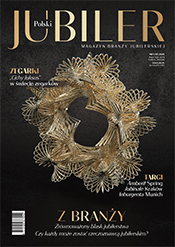 Identyfication and personalization of gemstones. History, modernity and technology of the NANORES company
Identyfication and personalization of gemstones. History, modernity and technology of the NANORES company
Since the dawn of history, gemstones have held significant material value. Due to the difficulty in finding deposits containing exceptional stones, they were considered luxury items, used as currency or as a safeguard for hard times. The first gemstones that caught human interest included agates, jaspers, rock crystals, amethysts, sapphires, and garnets, with large and unique pieces often ending up in the hands of wealthy families. These gems were frequently personalized by carving the owner’s likeness into them. This led to the development of the glyptic art of gem engraving.
Roman emperors, to emphasize their status, often had their portraits carved into gemstones. One famous example is a portrait of the Roman emperor known as Caracalla (Marcus Aurelius Antoninus) engraved on a beautiful amethyst. In 2019, Christie’s auctioned an extraordinary gem engraved in amethyst with the image of the Greek orator Demosthenes, dated to the 1st century BC, which sold for over $1.5 million.
In later centuries, other gemstones such as emeralds, rubies, sapphires, and diamonds began to reach the markets from the rich deposits of India. Large specimens made their way to royal courts, many brought by the well-known French merchant and traveler Jean-Baptiste Tavernier. At the time, personalization and identification of gems mainly consisted of documenting them in noble family inventories and often reproducing them in paintings. Renowned royal families would commission portraits in which kings and queens were painted in their royal attire adorned with crown jewels. One such example is a painting by Carle Van Loo from 1747, depicting Maria Leszczyńska, Queen of France, wearing the famous Sancy diamond (weighing 53 carats).
As for gemstone identification, an early example is a diamond inventory compiled by Cardinal Mazarin (1605–1661). It detailed diamonds included in the French Crown Jewels, listing each gem’s weight, cut, and value in French livres.
A unique gemstone that combines both personalization and identification is the Shah Diamond. Likely mined in India in the late 16th century, the rough diamond weighed about 95 carats and had a slightly yellow hue. Only three sides of the stone were polished, preserving much of its original weight—ending at 85 carats. The smooth surfaces were engraved with inscriptions of three successive owners: Burhan II (1591), Shah Jahan (1641), and Fath Ali Shah (1824).
Over time, the diamond industry began to develop methods for gem identification to ensure consumers received stones with trustworthy descriptions. In the 1970s and 1980s, certificates from the IGI laboratory became popular. Each diamond's characteristics were listed on a large certificate and a microfilm. The diamond was sealed together with a miniature version of the certificate and microfilm in a laminated package.
Identification methods continued to evolve. One major initiative was the Kimberley Process (KP)—a certification scheme aimed at regulating the trade of rough diamonds and preventing the circulation of conflict diamonds. The Kimberley Process Certification Scheme (KPCS) established rules for exporting countries, and its working groups (like the WGDE – Working Group of Diamond Experts) tackled successive stages of oversight. Additional groups, such as the WGAAP – Working Group on Artisanal and Alluvial Production, were created to monitor small-scale alluvial diamond mining and bring such diamonds into the regulated global market.
Next, additional security features were introduced for polished diamonds. Certificate numbers began to be laser-inscribed on the diamond's girdle. This allowed customers to verify a stone’s identity through laboratory websites. The idea of purchasing diamonds and jewelry from trusted sellers gained popularity—summarized in the "5 C’s" philosophy, with "confidence" (trust) being key. This was especially relevant during the rise of moissanites and, more recently, lab-grown diamonds.
Another advancement has been the establishment of information systems that track diamonds from the diamond mines, through polishing, to retail sale. One example is the use of blockchain systems, such as those developed by De Beers (diamond Tracr platform provenance), which improve the transparency of the international diamond trade. These systems help prevent the falsification or duplication of certificates, both for rough and polished diamonds.
A persistent issue, however, is theft in large jewelry stores. Stolen diamonds, once removed from their settings, often enter the secondary market. A key security feature against this is laser inscription. However, not all diamonds have certificate numbers engraved. This has led to the development of new technologies to secure diamonds of varying weights.
One such method was developed in the laboratory of the company NANORES, using nanotechnology to mark diamonds. This innovative technology allows for the placement of microscopic information (less than 3 microns in size) inside the stone, including data such as weight, clarity, proportions, cut type, and even a reproduction of the entire certificate.
Looking ahead, it would be highly beneficial for luxury jewelry brands (e.g., those from Place Vendôme) to adopt this nanotechnology—embedding their logos within the diamond itself. Information embedded using NANORES’ nanotechnology is permanent, which means such marked stones cannot enter the unregulated secondary market if stolen.
We invite you to watch the film https://youtu.be/_Jbl3ymd6AI?feature=shared
Barbara Dembowska
DIAMONDSLAB






